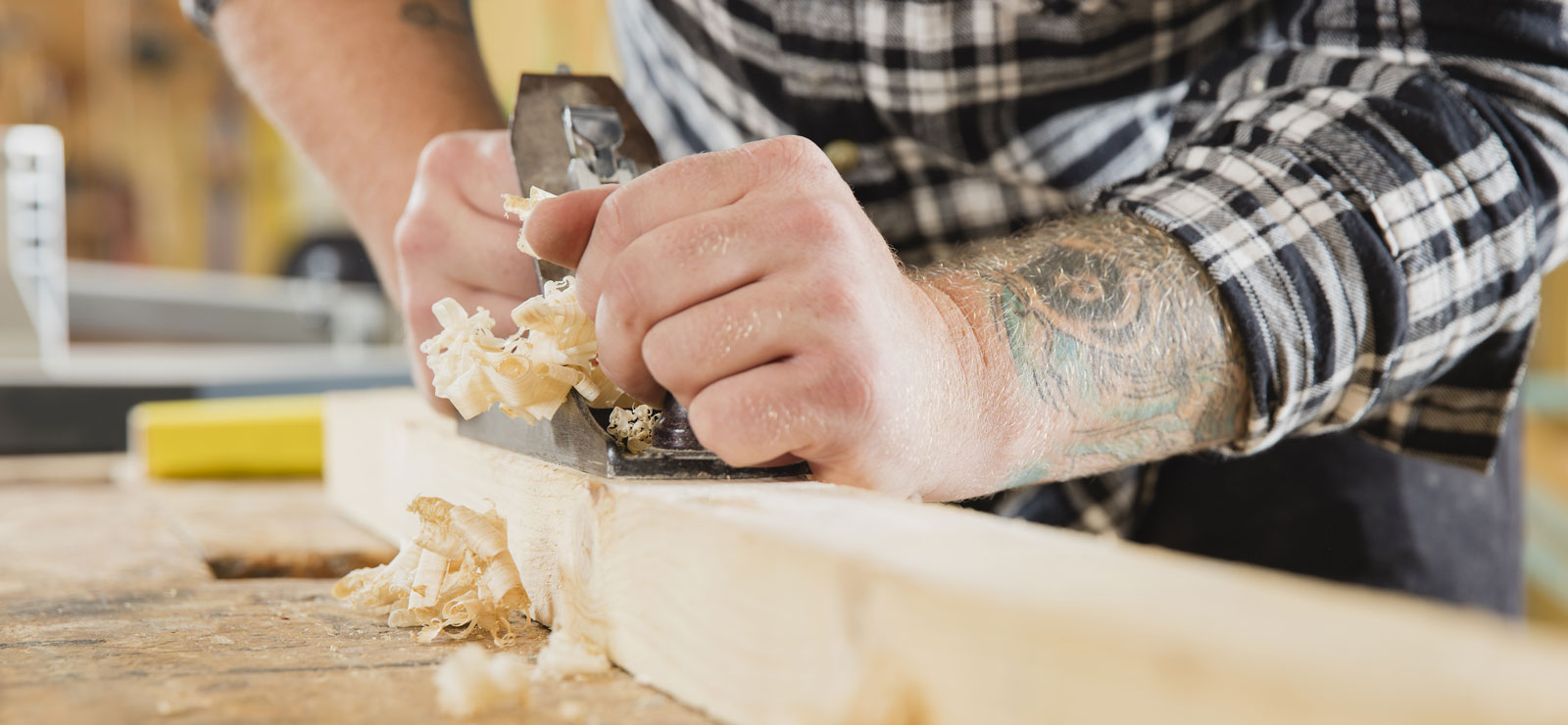
Glossary of Terms
Architrave
An architrave moulding is sometimes called a door header. It is the top horizontal trim piece over the door. It will be wider and thicker than the casing. You do not mitre the casing around the door when you use architrave. The casing comes up each side of the door and butts into the bottom of the architrave. Architrave moulding is a very classic look and can come as a one piece mould, or often built up out of three or more separate trim pieces.
Back Band
Back band is a decorative trim that is added to the outside edge of the casing to offer more depth and width to the casing detail. It has a rabetted edge that fits into the backside of the casing.
Baseboard
The baseboard ties the wall and floor together offering a visual foundation. It protects the walls from bumps and cleaning. The baseboard should compliment the style of casing and should be thinner and wider than the casing. Shoe mould often accompanies the baseboard if the floor is uneven or there is gaps between the baseboard and the flooring.
Base Cap
A base cap is used as a decorative piece that is placed on top of a dimensional board at the floor to create a two-piece baseboard. Base caps are also commonly used as decorative panel mouldings.
Bed Mould
A bed mould is similar to a crown or cornice mould but smaller in size.
Brick Mould
Brick moulding is an exterior casing for doors and windows. It is quite thick and allows siding or brick to butt up against it.
Burlap
Burlaps are often used to cover the joining line between two parallel flush surfaces. Burlaps are sometimes referred to as battons and are symmetrical in design.
Cap Mould
A cap mould is a generic term for a moulding that is designed to cap something off. Examples would be a wainscoting cap mould and a header cap mould. A header cap mould is similar to an architrave only you mitre the casing on all three sides of the door, then add the cap on the top portion only to get a more neo-classic look.
Casing
Casing is used to trim around doors and windows. It covers the gap between the drywall and the jamb. Casing is often the most prominent trim feature in your home and should be thicker than the baseboard. To increase the width and depth of the casing you can add a back band.
Casing Build up
A casing build up is two or more pieces of moulding put together to get a more custom look without the costs associated with a custom run. Often you can achieve a specific look by combining and layering multiple mouldings together.
Chair Rail
Chair Rail is applied on the wall parallel to the crown and base. Often it is installed approximately one-third the distance up the wall but can range anywhere from 28″ to 36” up the wall or even higher when paneling out a wall for wainscoting. Chair rail offers a traditional colonial look and can separate two wall colours in the room. Its original purpose was to protect the walls from the backs of chairs but is more commonly used for a visual effect.
Corner Blocks
Corner blocks are often referred to as rosettes and are decorative blocks placed in the top corners of the door and window casing. When using corner blocks you do not need to mitre the casing, as it will butt into the corner block.
Cove Mould
Cove mould is an inside corner concave in shape and comes in various sizes depending on the application. Larger coves are used as crown or cornice mouldings. Smaller cove moulds are used as inside corners as a guard, or to hide a rough or jagged edge.
Crown Mould
Crown moulding is applied where the ceiling and wall meet to offer a dramatic and elegant look to a room. Crown moulding is also referred to as cornice moulding, cove moulding and bed mould.
Decorative Mould
Decorative mouldings are used for various decorative applications in all aspects of millwork.
Door Jamb
Door Jamb is the square wood frame around the three sides of the door or four sides of a window. The casing gets attached to the sides of the jamb. The jamb will come in various standard widths to accommodate the 2×4 or 2×6 walls plus the thickness of the drywall on each side of the wall. The doorstop gets attached to the face of the jamb to prevent the door from swinging through the wrong way.
Door Stop
Doorstop is applied to door jambs to stop the door from swinging in the wrong direction. Doorstop is often used for other decorative trim uses including shoe mould applications for baseboard.
Fluted Moulding
A fluted moulding is often a wider and symmetrical casing with vertical flutes cut into it. Fluted moulding is sometimes referred to as pilaster or fluted pilaster. Common applications are casings on front entranceways and large and accented decorative windows. Fluted moulding should not be mitred. It is used with an architrave mould for the top header and plinth blocks at the bottom.
Half Round
Half round has a 180-degree half circle profile and has many applications in millwork.
Handrail
Hand railing is used as a safety rail for support in a stairwell. Handrail can be attached directly to a wall, or can be mounted to spindles, or balusters and join into a newel post at the top and bottom.
Keystone
A keystone is an architectural accessory that is placed in the centre of the architrave over doors and windows. A keystone looks similar to the wedge shaped stone used in masonry as the last piece at the apex of an archway.
Nosing
A nosing is often used at the top step and landing of stairwells. It is the part that projects past the vertical riser. Nosing’s often have a groove cut in the back of them where hardwood flooring can tongue into it at the top of the step or staircase.
Outside Corner Mould
An outside corner mould is used to protect an outside corner as an outside corner guard. It is also used hide rough or jagged edges on an outside wall corner.
Panel Mould
Panel mould is a decorative trim applied to the wall to add a visual relief to the wall. The panel mould is often accompanied by chair rail. Panel moulding can be used on the full face of the walls, or partially up the wall. On applied panel moulding, the 4 pieces are mitred together to form rectangles and are applied to the surface of the wall. In sunken panel applications it will have a rabbeted edge to accommodate the style and rails of the panels. The style and rails are the vertical and horizontal pieces that for the wall paneling. In sunken panel designs, the panel mould is often referred to as a bolection mould.
Plinth Block
Plinth blocks are another accessory similar to corner blocks, only they are placed at the bottom of the door casing where the door casing and baseboard would normally meet.
Quarter round
Quarter round moulding is a 90-degree inside corner moulding often used for shoe mould or any application where two adjacent surfaces meet.
Shingle Mould
A shingle moulding is another decorative moulding that can be used for many design applications. Traditionally it was used as an exterior moulding around window frames or on the rake of a building.
Shoe Mould
Shoe moulding is used where the floor and the baseboard meet. It is often referred to as quarter round. Other substitutes for quarter round include shingle moulds, and door stops. Shoe moulds are necessary when floor surfaces are uneven or when there are gaps between the baseboard and the flooring surface.
Stair Riser
The riser is the vertical portion of the staircase. Open riser staircases have no riser and are open through the vertical portion of the staircase.
Stair Spindle
A spindle is commonly referred to as a baluster. Spindles & balusters are the vertical supports that tie the handrail to the staircase.
Stair Tread
The stair tread is the actual stair step you walk up the stairs on. Solid wood treads are usually 1-1/16 inches thick. Carpeted stairs usually have 1-1/2 inch thick pine steps or 1-inch thick plywood for angled staircases. When covering carpet stairs with wood, you can remove the carpet and cap the treads with a wood tread cover. Wood tread covers are made in a variety of shapes and sizes for any staircase.
Threshold
A threshold is used at the bottom of an exterior door between the jambs. It covers two different floor coverings or to close a gap between the floor and door. It is usually beveled or tapered.
Transition Strip
A transition strip helps transition two different flooring surfaces together and hides any rough or irregular seams. It can also transition two different flooring heights together for a smooth transition. When there are different flooring heights, often the transition strip is referred to as a reducer.
Wainscoting
Wainscoting is used as a decorative relieve applied to wall surfaces usually between the chair rail and the baseboard. Wainscoting can be in the form of tongue and grove paneling, shadow box paneling, sunken panel and raised panel designs.
Window Sill / Stool
The sill or stool is the bottom portion of a window. In applications where a stool is used, the stool projects past the casing and a skirt or apron moulding is used underneath. Window stool or sill offers a very classic and finished look on a window but are not always used.
